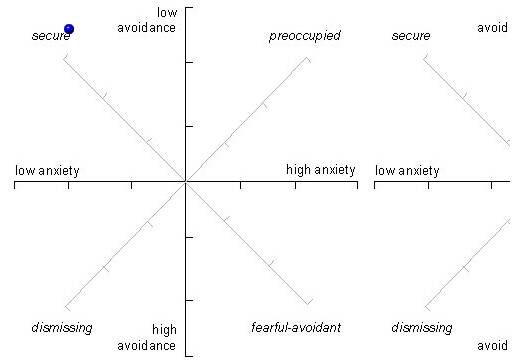Attachment survey – very interesting.
http://p034.psch.uic.edu/cgi-bin/crq.pl
Attachment Styles and Close Relationships
Mozilla/4.0 (compatible; MSIE 6.0; Windows 98; Win 9x 4.90)
Thank you for completing the Close Relationships Questionnaire/Experiences in Close Relationships-Revised Questionnaire. This questionnaire is designed to measure your attachment style—the way you relate to others in the context of intimate relationships. As you might suspect, people differ greatly in the ways in which they approach close relationships. For example, some people are comfortable opening up to others emotionally, whereas others are reluctant to allow themselves to depend on others.
According to attachment theory and research, there are two fundamental ways in which people differ from one another in the way they think about relationships. First, some people are more anxious than others. People who are high in attachment-related anxiety tend to worry about whether their partners really love them and often fear rejection. People low on this dimension are much less worried about such matters. Second, some people are more avoidant than others. People who are high in attachment-related avoidance are less comfortable depending on others and opening up to others.
According to your questionnaire responses, your attachment-related anxiety score is 1.56, on a scale ranging from 1 (low anxiety) to 7 (high anxiety). Your attachment-related avoidance score is 1.39, on a scale ranging from 1 (low avoidance) to 7 (high avoidance).
We have plotted your two scores in the two-dimensional space defined by attachment-related anxiety and avoidance. Your approximate position in this space is denoted by the blue dot. (Note: If you left any of the questions unanswered, then these scores will be inaccurate.)

As you can see in this graph, the two dimensions of anxiety and avoidance can be combined to create interesting combinations of attachment styles. For example, people who are low in both attachment-related anxiety and avoidance are generally considered secure because they don’t typically worry about whether their partners are going to reject them and they are comfortable being emotionally close to others.
Combining your anxiety and avoidance scores, you fall into the secure quadrant. Previous research on attachment styles indicates that secure people tend to have relatively enduring and satisfying relationships. They are comfortable expressing their emotions and tend not to suffer from depression and other psychological disorders.
I’m reasonably certain that if I’d taken the same survey pre-Sam, the results would have been MUCH different.
